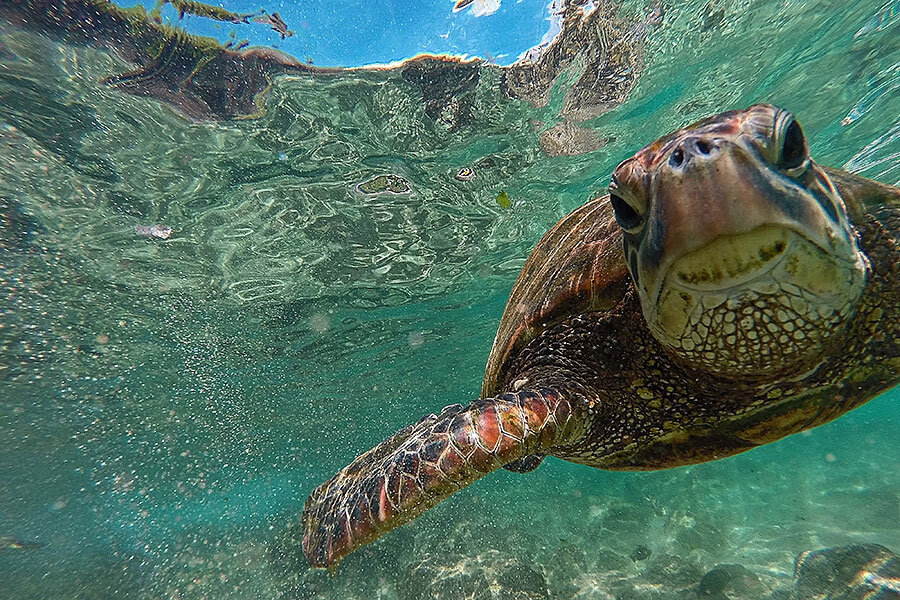Can you ever have too many turtles?
Loading...
Raine Island is a tiny coral outcrop, nestled in the balmy tropical waters between northern Australia and Papua New Guinea. It should be a turtle paradise.
Indeed, this afterthought of an island is the world’s largest nesting site for one particular species, the green turtle. It presents a perfect picture: sweeping sandy beaches protected by coral fringes, with no land-based predators.
Yet the rate of successful hatches has dropped to pitiful levels, hovering at 30 percent. Scientists had been left baffled, but after exploring various possibilities, they think they have the answer, and it holds important implications for turtle conservation worldwide.
“It’s a really interesting study,” says Margaret Lamont, a marine biologist with the US Geological Survey whose research focuses on sea turtles, and who was not involved in the research. “A lot of people, including scientists and conservation managers, originally thought the nest environment for turtles was fairly simple, little more than a hole in the ground, and then the turtles emerge.
“What we’re finding is it’s really complex,” adds Dr. Lamont, in a telephone interview with The Christian Science Monitor.
The researchers, hailing from Australia's Queensland Parks and Wildlife Service and the University of Queensland, thought the culprit might be flooding of the nests at high tide. They shipped a bulldozer to the island in 2014, raised a section of the beach by 3 to 5 feet, and observed.
The nests in the modified area were well clear of the sea level, even at high tide, but the hatching rates remained extremely low.
The following year, the scientists were given a clue: Hatching success nearly doubled, though the scientists had changed nothing. The turtles, however, had done something differently: Fewer had nested.
“Essentially, the study is saying, at a certain point, there are so many nests that it becomes harmful,” explains Lamont. “There is a limited amount of resources, and consequently a limited number of nests the beach can support.”
The concept is known as “density dependence,” and while Lamont says the ideas presented in this study are not new, the work does highlight the complexity of the beach environment and the impact of density dependence on turtles' hatching success.
Moreover, as Brendan Godley, director of the University of Exeter’s Centre for Ecology and Conservation in England, tells the Monitor, Raine Island is an ideal place to study these ideas because few places on the globe can rival it for the sheer number of nesting turtles. But more work is needed.
“We need to move forward and do some more experiments,” says Dr. Godley in a phone interview, “because it’s hard to disentangle egg numbers from sea-level rise and increasing temperatures, things people are concerned about in some sites.”
At present, the researchers from Australia postulate three likely factors in turtle hatching: too little oxygen, too much carbon dioxide, or too many adversarial microorganisms, all of which could be caused by an excess of eggs.
But while it would be “very interesting to know the root cause,” Godley points out that turtle conservation in general is seeing substantial success. The very fact that a beach is overwhelmed by the number of turtles trying to lay eggs could be a cause for celebration.
In particular, since the conservation drive gained momentum in the late 20th century, industrial harvesting of turtles for consumption has largely ceased. Godley puts the figure of direct take at about one percent of what it was 100 years ago.
At this point, the greatest threats come from small-scale fisheries, whose fishermen take tens of thousands of turtles every year, either by accident or intentionally, and large-scale fisheries, whose massive nets until recently took in huge numbers of turtles.
“There is no better example of someone partnering from within industry with conservationists, scientists, and policymakers than what happened with the shrimp industry in southern USA,” says Lamont. “They cooperated, and I believe it was in fact a commercial shrimper who designed the turtle excluder that can be fitted on nets and allows turtles to escape if they become trapped.”
Ongoing turtle research like the work in Raine Island helps conservation managers refine their methods and goals.
“In general, we’re making a big difference,” says Lamont. “The future looks bright for the turtles.”








